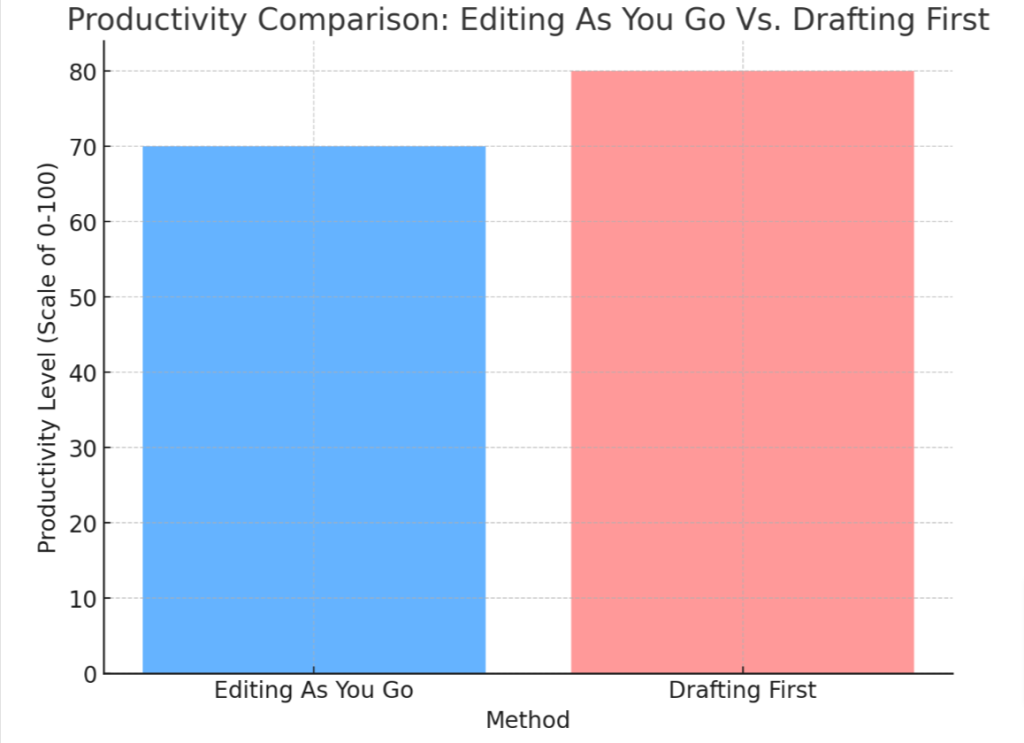The Writing Dilemma: Balancing Editing and Drafting for Optimal Results
Are you a writer tangled in the dilemma of editing as you go versus drafting? Here’s an intriguing fact: there’s no one-size-fits-all solution to this debate! This blog post will shed light on both approaches, unpacking their pros and cons to empower your writing process.
Curious to find out which method could supercharge your writing? Keep reading!
Key Takeaways
- Editing as you go involves making changes and revisions to your work while still in the process of drafting. It can benefit structured writers by maintaining a clear and organized flow, spotting inconsistencies early on, and enhancing the overall quality of their writing.
- Discovery writers who edit as they go can experience enhanced creativity, improved organization, clarity of message, smooth transitions, immediate feedback, reduced revision time, a more polished final product, and increased confidence in their work.
- Potential drawbacks for both approaches include loss of momentum, over – editing that stifles fresh ideas or creativity, difficulty in finishing drafts or projects, lack of objectivity when evaluating one’s own work closely during editing as you go.
What is Editing as You Go?
Editing as you go is a writing approach that involves making changes and revisions to your work while you are still in the process of drafting.
The structured approach
The structured approach involves meticulous planning before you start writing. This method requires a detailed outline with clearly defined sections, sub-sections, and bullet points for each section.
Every idea is laid out in an organized manner before the actual writing begins. The writer knows exactly what they want to say and how they’re going to say it. They continuously revise and edit as they write, ensuring that their work is polished right from the first draft.
This method demands discipline but can save time by reducing drastic revisions after completing the initial draft.
The discovery approach
The discovery approach attracts writers who thrive on spontaneity and exploration. Instead of sticking to a rigid plan, they let the story unfold naturally as they write. This method is akin to an exciting adventure, enabling you to uncover your plot and characters in unexpected ways.
One charm of the discovery writing process lies in its freedom. Without pre-determined outlines or constraints, creativity can flow uninhibited. On-the-go editing fits well into this approach – fixing issues as they arise and making sure every part aligns with the evolving storyline.
The figure-it-out-as-you-go approach
The figure-it-out-as-you-go approach liberates writers from sticking to a premeditated plan. You start with an idea or seed of a story and let the plot grow organically. It lets your writing flow freely, steering through unexpected twists and turns in your storyline that often lead to exciting discoveries.
This technique suits those who thrive on spontaneity, allowing creativity to take control while drafting their manuscript. The risk? You might face writer’s block or lack direction at times, particularly when tackling complex narrative structures or novel-length work-in-progress (WIP).
However, this strategy bolsters creative writing skills as you’re constantly solving storytelling puzzles during the writing process itself.

The Pros and Cons of Editing as You Go
Editing as you go has its pros and cons. Structured writers benefit from a more organized approach, allowing them to perfect their work as they go along. On the other hand, discovery writers find that editing as they go stifles their creativity and prefer to let the story unfold naturally before making any changes.
However, both approaches have potential drawbacks such as losing momentum or getting stuck in a perpetual cycle of editing without progressing further.
Benefits for structured writers
Structured writers often find that editing as they go allows them to maintain a clear and organized flow in their writing. They can easily spot inconsistencies, plot holes, or errors early on, making it easier to fix them before they become bigger issues later.
This approach also helps them stay focused on the structure and overall coherence of their work. Additionally, structured writers may find that editing as they go allows them to better develop the fine details of their story or argument, enhancing the overall quality of their writing.
Benefits for discovery writers
Discovery writers benefit from editing as they go in several ways:
- Enhanced creativity: By editing as they go, discovery writers can refine their ideas and make them more coherent, allowing their creativity to flow smoothly.
- Improved organization: Editing as they go helps discovery writers to structure their thoughts and ideas, making it easier for readers to follow along.
- Clarity of message: By continuously editing while writing, discovery writers can ensure that their message is clear and effectively communicated to the reader.
- Smooth transitions: Editing as they go allows discovery writers to fine-tune the transitions between paragraphs and sections, creating a seamless flow throughout the piece.
- Immediate feedback: Discovery writers who edit as they go can receive immediate feedback on their writing style, tone, and content, helping them make necessary adjustments sooner rather than later.
- Reduced revision time: With continuous editing during the writing process, discovery writers have fewer revisions to make once the draft is complete, saving time in the long run.
- More polished final product: By focusing on editing as they go, discovery writers produce a more polished final piece that requires less extensive revision or proofreading before publication or submission.
- Increased confidence: Editing as they go boosts confidence for discovery writers by allowing them to see progress in their work and providing a sense of accomplishment along the way.

Potential drawbacks for both approaches
Both editing as you go and drafting have their drawbacks. Here are some potential drawbacks for both approaches:
- Loss of momentum: Constantly stopping to edit can disrupt the flow of your writing and cause you to lose your train of thought.
- Over-editing: Editing as you go may lead to excessive revising, resulting in the loss of fresh ideas or creativity.
- Difficulty in finishing: If you constantly edit as you go, it can be challenging to complete a draft or reach the end of your writing project.
- Lack of objectivity: When editing as you go, it can be difficult to objectively evaluate your work since you are too close to it.
- Inefficient use of time: Spending too much time on editing during the writing process may lead to decreased productivity and slower progress.
- Potential for missing errors: Focusing on editing while writing may cause you to overlook typos, grammar issues, or other mistakes in your work.
- Limited exploration: By constantly refining sentences and paragraphs, you may miss opportunities for new ideas or alternative approaches that could enhance your writing.
- Increased self-doubt: Frequent editing can amplify self-criticism and make it harder to believe in the quality of your work.
Factors to Consider
When deciding whether to edit as you go or draft, there are several factors to consider. Fiction and non-fiction writing might require different approaches, while the length of your project and your experience level can also play a role.
Additionally, how you prepare and outline, your drafting speed, and your lifestyle demands all come into play. Understanding these factors will help you find the best process for you.
Want to know more? Keep reading!
Fiction vs. Non-fiction
Fiction and non-fiction writing have different considerations when it comes to the editing process. In fiction, authors often need to focus on structure, fine details, and creating a captivating story.
Editing as you go can be helpful in ensuring that the story flows smoothly and the plot is engaging. On the other hand, non-fiction writers may prioritize factual accuracy and presenting information clearly.
They might benefit from drafting first before diving into extensive editing. Both approaches have their pros and cons, so it’s important for writers to consider their genre and personal preferences when deciding which method works best for them.
Length of the project
Consider the length of your writing project when deciding whether to edit as you go or draft first. For shorter projects, like blog posts or articles, editing as you go can be more efficient.
It allows you to catch errors and make improvements in real-time, resulting in a polished piece from the start. On the other hand, longer projects such as novels require a different approach.
Drafting first allows you to focus on getting your ideas down without being bogged down by constant editing. This way, you can maintain momentum and complete your work before diving into the editing process later on.
Preparation and outlining process
The preparation and outlining process is an essential step in determining the best approach for your writing. It involves considering factors such as whether you’re working on fiction or non-fiction, the length of your project, your writing experience, and even your drafting speed.
By taking these factors into account, you can better understand which method – editing as you go or drafting – will work best for you. Don’t be afraid to experiment with different methods and be open to adjusting your process as needed to find what works most effectively for your personal style and strengths.
This way, you can optimize your writing process and produce the best possible results.
Writing experience
Writers with more experience may find it easier to edit as they go. They have a better understanding of the writing process and can identify potential issues or areas for improvement as they write.
With their knowledge and skills, experienced writers can make adjustments in real-time, resulting in a smoother final product. However, less experienced writers may benefit from drafting first before editing.
By getting their ideas down on paper without interruption, they can focus on creativity and flow rather than constantly self-editing. Ultimately, finding the right approach depends on the individual writer’s comfort level and familiarity with the writing process.
Drafting speed
Writers often have different speeds when it comes to drafting their work. Some writers may be able to write quickly and produce a first draft in a short amount of time, while others may take longer to develop their ideas.
The speed at which you draft can impact your writing process and the choices you make along the way. For example, if you write quickly, you may focus more on getting your ideas down on paper without worrying about grammar or punctuation errors.
On the other hand, if you take more time with your draft, you might be able to catch mistakes as you go and refine your sentences as you write them. It’s important to consider your drafting speed and how it aligns with your goals for editing as you go versus drafting first and then editing later in the writing process.
Finding Your Personal Process
Discovering your own writing process is essential for finding success in your craft. By understanding your strengths and experimenting with different methods, you’ll be able to optimize your productivity and creativity.
So, if you want to learn more about finding the right approach for you, keep reading!

Know your writing style and strengths
Understanding your writing style and recognizing your strengths is crucial in finding the best approach to editing as you go or drafting. Take some time to reflect on how you like to write and what aspects of the process come naturally to you.
Are you more structured, needing a clear plan before diving into writing? Or do you prefer a discovery approach, where ideas unfold as you go? By knowing yourself as a writer, you can make an informed decision about which editing method aligns with your style and plays to your strengths.
Keep experimenting and be open to adjusting your process if needed for optimal results.
Experiment with different methods
Try out various techniques to find the best approach for your writing:
- Write a complete draft before making any edits.
- Edit as you go, refining each paragraph or section before moving on.
- Take a hybrid approach, editing some parts while drafting others.
- Use different methods for different projects to see which works best for each.
Be open to adjusting your process as needed
Adjusting your writing process is crucial to finding what works best for you. Writing styles and preferences vary from person to person, so it’s important to experiment with different methods and be open to making changes along the way.
Don’t be afraid to try new approaches or modify your existing process if it’s not yielding the desired results. By being flexible and adaptable, you can find a writing routine that maximizes your productivity and creativity.
Remember, there’s no one-size-fits-all approach, so be willing to adjust as needed.
Conclusion
In conclusion, the debate between editing as you go and drafting comes down to personal preference and writing style. Some writers thrive on the structure and attention to detail that comes with editing as they write, while others prefer the freedom and creativity of drafting first.
Ultimately, finding your own process involves understanding your strengths, experimenting with different methods, and remaining open to adjustments along the way. So whether you choose to edit as you go or draft first, what matters most is finding a process that allows you to produce your best work.

